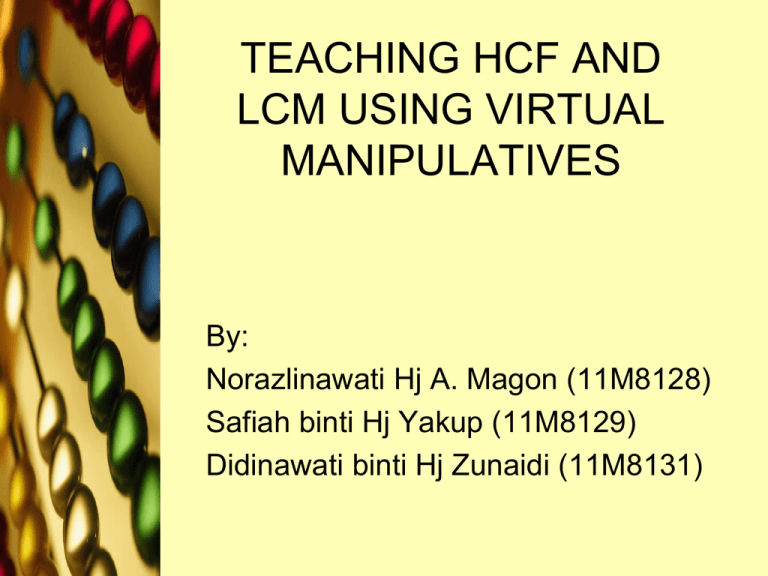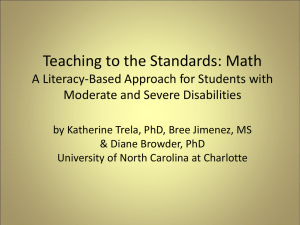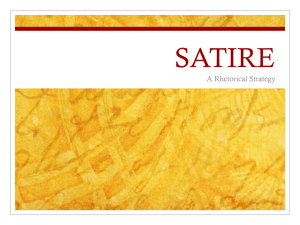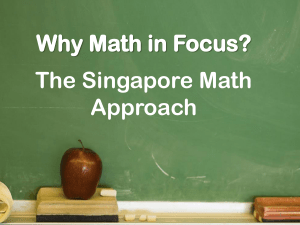teaching hcf and lcm using virtual manipulatives
advertisement

TEACHING HCF AND LCM USING VIRTUAL MANIPULATIVES By: Norazlinawati Hj A. Magon (11M8128) Safiah binti Hj Yakup (11M8129) Didinawati binti Hj Zunaidi (11M8131) Introduction • The new National education system 21st century in Brunei Darussalam promotes the use of technology in teaching and learning of mathematics in schools. • The mathematics curriculum supports the developments in children by placing clear emphasis upon the sensible use of ICT in classroom (CDD, 2008 p.9) www.brainybetty.com 2 Emphasis use of ICT Technology assisted instruction Interactive learning Use of ICT in concept development Problem solving Modelling www.brainybetty.com 3 Background • This research investigated whether the use of virtual manipulative could improve pupils’ achievement and attitudes in mathematics. • The researchers explored the use of technology in the teaching and learning of factors and multiples in Year 6. • The researchers used free virtual manipulative software obtained online from http: //nlvm.usu.edu/. www.brainybetty.com 4 Background • The software ‘Factor Tree’ was used to help the pupils to learn the topics found to be difficult for pupils. • Reasons of using Virtual manipulatives to teach the Factors and Multiples : a) Provide learners with visual images. b) It can be manipulated as physical manipulatives and provide students opportunities for constructing mathematical knowledge. c) To promote effective teaching. www.brainybetty.com 5 Background • Benefits of using Virtual manipulatives : a) It can help students visualize relationships and engage students learning actively. b) Useful to help the students to understand better. c) It will arouse students’ interest in learning mathematics. d) Pupils can work out the answer faster by using the virtual manipulatives. www.brainybetty.com 6 Background • Benefits of using Virtual manipulatives : e) It can help students visualize relationships and engage students learning actively. f) Useful to help the students to understand better. g) It will arouse students’ interest in learning mathematics. h) Pupils can work out the answer faster by using the virtual manipulatives. www.brainybetty.com 7 Research Questions • Are there any improvement in students’ achievement or scores in answering questions on factors (HCF and LCM) after using Virtual Manipulatives? • Do students’ attitude towards mathematics affect their mathematics achievement? www.brainybetty.com 8 Literature Review • Abstract concepts are essential to understanding and performing mathematics. They are also a source of difficulty for many students who struggle with mathematics, many of whom find even basic mathematics concepts difficult to understand. www.brainybetty.com 9 Literature Review • A popular approach to help students understand abstract concepts is the use of manipulatives. • Manipulatives enable students and teachers to represent concretely the abstract concepts that they are learning in mathematics class and to link these concepts to prior knowledge. • Manipulatives are useful to introduce new concepts to all students www.brainybetty.com 10 Literature Review • For the most part, classroom use of manipulatives has involved concrete, or physical, manipulatives. However, with the advent of the World Wide Web, there is a new category of manipulatives. • Virtual manipulatives are basically digital “objects” that resemble physical objects and can be manipulated, usually with a mouse, in the same ways as their authentic counterparts. www.brainybetty.com 11 Literature Review • Virtual manipulatives are a relatively new technology and are modeled after existing manipulatives such as base ten blocks, coins, blocks, tangrams, spinners, rulers, fraction bars, algebra tiles, geoboards, geometric plane and solids figures. • They are usually in the form of Java or Flash applets. www.brainybetty.com 12 Literature Review • Virtual manipulatives : 1) allow teachers to allow for efficient use of multiple representations and 2) to provide concrete models of abstract mathematical concepts for learners of mathematics. • Research suggests that students may also develop more connected understandings of mathematical concepts when they use virtual manipulatives (Moyer, Niezgoda, & Stanley, 2005) www.brainybetty.com 13 Methodology - instruments • The researchers used both quantitative and qualitative methods: a) pre- and post-tests b) questionnaires on attitudes towards mathematics c) feedback on using the virtual manipulatives d) informal observation of pupils attitude in class e) Teacher’s reflection form www.brainybetty.com 14 Methodology - instruments • Face validity, content validity and reliability The test items were shown to our lecturer to be checked and finalized. The items were constructed based on Primary School Examination (PSR) format questions. The final questions were checked by the Year 6 mathematics teachers before given to the pupils. The alpha reliability of the 10 items is 0.803, which rounded to two decimal places is 0.80, indicating that the scale had good reliability. www.brainybetty.com 15 Methodology- samples • The researchers used one intact class for the study. There were twelve boys and sixteen girls in the sample. • The researchers worked together with the class teacher in delivering the lessons. www.brainybetty.com 16 Methodology- samples • The researchers found that at the beginning, out of 28 Year six pupils, majority were not able to correctly find the LCM and HCF of given set of numbers. www.brainybetty.com 17 Findings and Results • Initially the pupils were quiet, listening to a demonstration by the class teacher and then later the researchers noticed that the students were enthusiastic and deeply engaged with the activities in the lessons. www.brainybetty.com 18 Findings and Results • The researchers found at the end of the study, Cohen’s effect size, d = 1.83, indicating a large effect at the 96.4th percentile. www.brainybetty.com 19 Findings and Results Table 2 shows the mean score for pre-test and post-test of 28 pupils. The mean score for pre-test = 0.07 and post-test = 3.68. There is a significant difference in the mean scores between the pretest and posttest at p < 0.025 level (2-tailed). The pupils performed significantly better in their posttest scores. This implies that the use of virtual manipulative (Factor Tree) may be effective in enhancing pupils’ academic performance. www.brainybetty.com 20 Findings and Results Table 2 shows that female pupils (M=4.00, SD = 2.98) performed better than male pupils (M = 3.18, SD = 2.48). But Cohen’s d=0.3 indicated only small effect. www.brainybetty.com 21 Findings and Results There is no significant relationship between attitude towards mathematics and mathematics scores (r= 0.232, p = 0.24). Pupils’ attitude towards mathematics did not affect the total mathematics scores. www.brainybetty.com 22 Findings and Results www.brainybetty.com 23 Conclusion On attitude toward mathematics: • 75% like learning mathematics. • 69% (19) said mathematics is fun to learn. On Feedback on Virtual Manipulatives • 86% of the students like virtual manipulatives; 61% find it easy to play; 50% know how to find the prime factors, 64% LCM and 68% HCF using the manipulatives; 79% like the topic and 82% enjoy the lesson. www.brainybetty.com 24 Conclusion Teacher reflection form: • The benefits of using the virtual manipulatives as: a) useful to help pupils to understand better b) arose pupils’ interest in learning mathematics c) pupils can work out the answers faster • The objectives of the lesson were achieved as the pupils could use the virtual manipulatives software effectively in answering the questions given www.brainybetty.com 25 Conclusion Teacher reflection form: • The software also worked in developing the lesson plan as pupils use the virtual software in expressing a given number as a product of prime factors. • She also stated that the new method (using the software) in finding the GCF (HCF) and LCM is simple and easy to understand. • The software is also only need simple working to get the answer. www.brainybetty.com 26 Conclusion From the mean scores of 0.7% correct responses in the pre-test and 36.8% in the post-test, it can be seen there is an improvement in student’s achievement in answering questions on factors (HCF and LCM) after using virtual manipulatives. www.brainybetty.com 27 Recommendations • The concepts and skills to be learned from the virtual manipulatives activities (in teaching the Factors and Multiples) are: • Can make connections between the concepts, extension and generalizations in order to solve the problems. • Identify prime and composite numbers. • Find factors and multiples of whole number less than 100 and identify which are prime or composite. • Identify common factors of a set of whole numbers. www.brainybetty.com 28 Recommendations • The concepts and skills to be learned from the virtual manipulatives activities (in teaching the Factors and Multiples) are: • To manipulate and change the representations, thus increasing exploration possibilities to develop concepts and test hypotheses • Know how to use technology. • Learn by using factor tree method through games. • To develop their relational thinking and to generalize mathematical ideas www.brainybetty.com 29 Recommendations • Related Technological Activities to Factors and Multiples • http://www.mathgoodies.com/factors/fa ctor_tree.asp • http://www.math-play.com/Factors-andMultiples-Jeopardy/Factors-andMultiples-Jeopardy.html • http://www.toonuniversity.com/flash.asp ?err=499&engine=14 • http://www.mathplayground.com/factort rees.html www.brainybetty.com 30 Bibliography • Curriculum Development, Ministry of Education, Brunei Darussalam (2009). Framework and Guidelines for Curriculum and Assessment Mathematics Year 6. • National Library of Virtual Manipulatives (2006). Retrieved March 3, 2012 from http://nvlm.usu.edu/en/nav/vlibrary.html. Utah State University. • Yuan, Y. (Dec, 2009).Taiwanese elementary school teachers apply web-based virtual manipulatives to teach mathematics. Journal of Mathematics Education, 2 (2), 108 - 121. www.brainybetty.com 31







